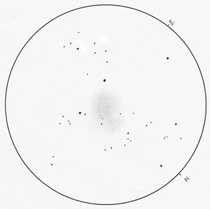 Here's another very difficult object. With an average surface brightness of 24.7 magnitudes per square arcsecond, very dark skies and excellent transparency are a must when going after Palomar 5. Discovered in 1950 by Walter Baade, astronomers have since found evidence that this cluster is being shredded by the Milky Way. My sketch presents this carnage as seen at 109X in my 18-inch (46 cm) Dobsonian. 9.0 magnitude HD 135660 marks the southeast edge of the cluster. Best seen with averted vision, Palomar 5 emerges northward from this bright star. The ancient cluster appears as a 7' by 3'.5 oval and is elongated northwest to southeast. Its mottled appearance and irregular shape are nearly unique among the nearly 80 globulars I've observed. It's possible one or two of the 15th magnitude stars seen within that feeble glow are cluster members. The brightest of Palomar 5's stars shine at 15.5 magnitude, well within the reach of my scope. As with Palomar 4, this globular was initially thought to be a nearby dwarf galaxy and Palomar 5 was nicknamed the Serpens Dwarf. While you're in the area, be sure to check out nearby M5. M5 is truly one of the magnificent showpieces of the summer sky and it lies just over 2 degrees north of Palomar 5.
Here's another very difficult object. With an average surface brightness of 24.7 magnitudes per square arcsecond, very dark skies and excellent transparency are a must when going after Palomar 5. Discovered in 1950 by Walter Baade, astronomers have since found evidence that this cluster is being shredded by the Milky Way. My sketch presents this carnage as seen at 109X in my 18-inch (46 cm) Dobsonian. 9.0 magnitude HD 135660 marks the southeast edge of the cluster. Best seen with averted vision, Palomar 5 emerges northward from this bright star. The ancient cluster appears as a 7' by 3'.5 oval and is elongated northwest to southeast. Its mottled appearance and irregular shape are nearly unique among the nearly 80 globulars I've observed. It's possible one or two of the 15th magnitude stars seen within that feeble glow are cluster members. The brightest of Palomar 5's stars shine at 15.5 magnitude, well within the reach of my scope. As with Palomar 4, this globular was initially thought to be a nearby dwarf galaxy and Palomar 5 was nicknamed the Serpens Dwarf. While you're in the area, be sure to check out nearby M5. M5 is truly one of the magnificent showpieces of the summer sky and it lies just over 2 degrees north of Palomar 5. |
![]()
![]()
